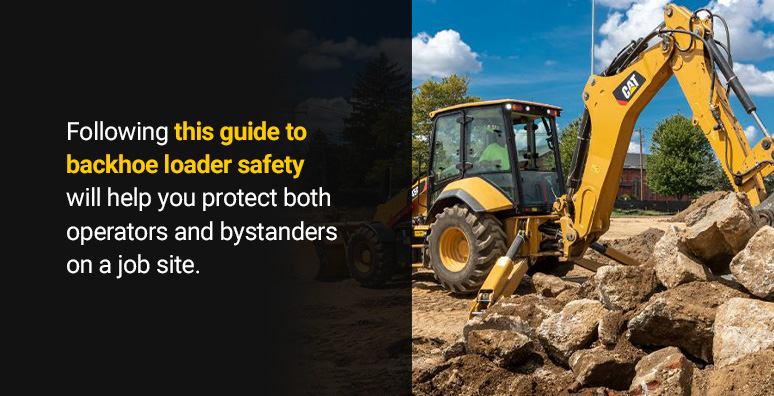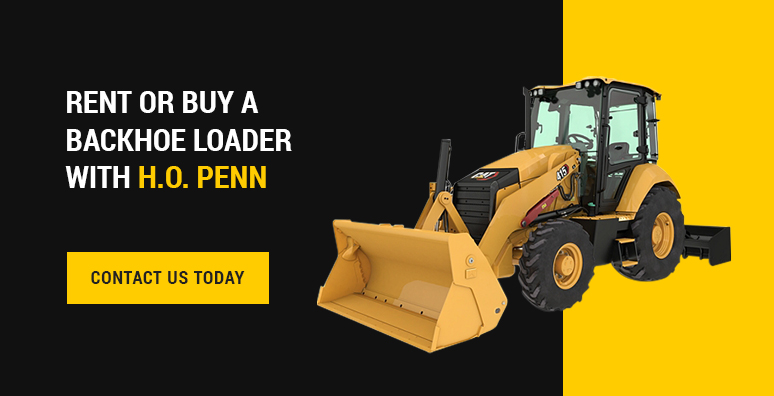The backhoe loader is a versatile powerhouse that can support any operation, but harnessing its full potential requires more than mechanical skill — it demands a deep understanding of how these machines work and how to use them safely.
Knowing a few tips on operating backhoe loaders will help users who are new to this type of machinery. Workers need to be familiar with measures like preoperation checks, load management and communication protocols so they can maintain a safe work site and use these loaders as efficiently as possible.
Main Parts of a Backhoe Loader
Before looking at operating tips, here is a quick look into the main components of a backhoe loader and how they work together:
- Front loader assembly: The front of the backhoe loader features two arms ending in a large articulated bucket. These arms are connected to a hydraulic system that powers their movement. The loader assembly is essential for loading, digging and material handling tasks.
- Backhoe attachment: Situated at the rear of the machine, the backhoe attachment consists of a hydraulic arm with a digging bucket. This arm is capable of pivoting and digging into the earth. The backhoe attachment excels in tasks like trenching, excavation and digging in confined spaces.
- Stabilizers and outriggers: Backhoe loaders are equipped with stabilizers or outriggers to ensure stability during digging and lifting operations. These extendable legs deploy from the sides of the machine to provide a firm base, preventing tipping and maintaining safety.
- Operator’s cab: The operator’s cab is the command center of the backhoe loader. It houses controls, levers and instruments necessary to operate the loader and the backhoe. The cab protects the operator and provides ergonomic support for comfort during long hours of operation.
- Engine and powertrain: The engine generates the power needed to operate hydraulic systems and provide mobility. The power is transmitted through a complex network of components, including gears, transmissions and axles, to ensure seamless movement.
- Hydraulic systems: Hydraulics power the movements of the loader and backhoe attachments, providing the force required for lifting, digging and maneuvering.
A backhoe loader’s buckets can also be replaced by other types of attachments to accomplish specialized tasks.
How to Operate a Backhoe Loader Safely
Using heavy machinery demands skill, efficiency and a commitment to safety. Following this guide to backhoe loader safety will help you protect both operators and bystanders on a job site.

- Preoperational inspection: Begin every work session with a thorough inspection. Check fluid levels, inspect tires or tracks for wear, and ensure all safety features, including lights, mirrors and warning signals, are operational.
- Operator training and certification: Only trained and certified personnel should operate a backhoe loader. Proper training ensures operators know the machine’s controls, safety protocols and emergency procedures.
- Cabin setup and seat belt: Before starting, adjust the operator’s seat, mirrors and controls to ensure optimal visibility and comfort. Always fasten the seat belt to prevent ejection during sudden movements.
- Clear communication: Establish clear communication protocols with colleagues and ground personnel. Ensure everyone knows your intended actions to keep the chance of accidents to a minimum.
- Stabilizers and outriggers: When using the backhoe attachment, deploy stabilizers or outriggers to enhance stability. Ensure they are on solid ground and fully extended to prevent tipping.
- Bucket and arm position: Keep the bucket and arm close to the ground when moving to maintain balance. Never transport materials with the bucket elevated, as this can lead to instability.
- Loading and unloading: Avoid abrupt movements to prevent sudden weight shifts that could compromise stability.
- Digging safety: Avoid positioning the arm or bucket over the cabin or operator when using the backhoe attachment. Maintain a safe distance from the edge of trenches or excavations to prevent collapse.
- Avoid overloading: Respect the backhoe loader’s load capacity. Overloading the bucket or loader assembly can lead to instability, compromising the machine’s balance.
- Safe parking and shutdown: Park the backhoe loader on level ground with the bucket or attachment lowered. Engage the parking brake, turn off the engine and remove the key when not operating.
- Maintenance and repairs: Regularly inspect and maintain the backhoe loader. Address mechanical issues promptly and perform routine maintenance to ensure optimal performance and safety.
- Emergency procedures: Familiarize yourself with emergency shutdown procedures and the location of fire extinguishers and first aid kits. In an emergency, act swiftly to ensure everyone’s safety.
What Backhoe Loaders Are Used For
These multipurpose machines combine the functionalities of a loader and a backhoe, making them indispensable assets in various projects. Backhoe loaders can contribute to many kinds of projects, from intricate landscaping to heavy-duty excavation. Here are a few ways companies often put backhoes to work:
- Excavation and trenching: Backhoe loaders have the power and attachment compatibility to dig through various terrains to create foundations, utility trenches and channels for drainage systems, making them ideal for municipal and residential construction work.
- Utility and pipeline work: In utility and pipeline installations, backhoe loaders excavate trenches for laying pipes, conduits and utility lines with precision, ensuring the integrity of essential infrastructure.
- Landscaping and grading: For landscaping and grading projects, backhoe loaders offer finesse and efficiency. They sculpt terrain, level surfaces and create contours to establish outdoor spaces for gardens, lawns and recreational areas.
- Material handling: The loader assembly of a backhoe loader can transform it into an adept material handler.
- Foundation and footing work: Backhoe loaders are pivotal in foundation and footing construction. They excavate pits, trenches and holes for footings, ensuring stable and secure bases for buildings and structures.
- Road maintenance: Backhoe loaders contribute to road maintenance by clearing debris and grading surfaces. Their versatility and ease of operation make them valuable for urban roadwork.
- Demolition: In demolition projects, backhoe loaders assist in dismantling structures efficiently. Their backhoe attachments enable the precise removal of building components while maintaining operator control and safety.
- Site preparation: Backhoe loaders prepare construction sites by clearing vegetation, removing obstacles and creating a suitable environment for subsequent construction phases.
- Digging pools and ponds: Backhoe loaders assist in digging pools, ponds and water features. The backhoe attachment allows for controlled excavation, shaping water elements with accuracy.
- Cable and fiber optic installation: In cable and fiber optic installations, backhoe loaders create pathways for cables underground. Their digging capabilities minimize disruption to the surface while accommodating essential infrastructure.
Rent or Buy a Backhoe Loader With H.O. Penn
With locations across New York and Connecticut and a deep-rooted commitment to customer success, H.O. Penn is here to help you find the backhoe loaders, work tool attachments and parts you need for a fully equipped fleet. Our offerings extend beyond machinery, including the level of support and service you expect from a trusted partner.
Whether you need backhoe loader parts, a whole new machine or just guidance on using your equipment to its best effect, our team is here to help. Contact us today for more information.

